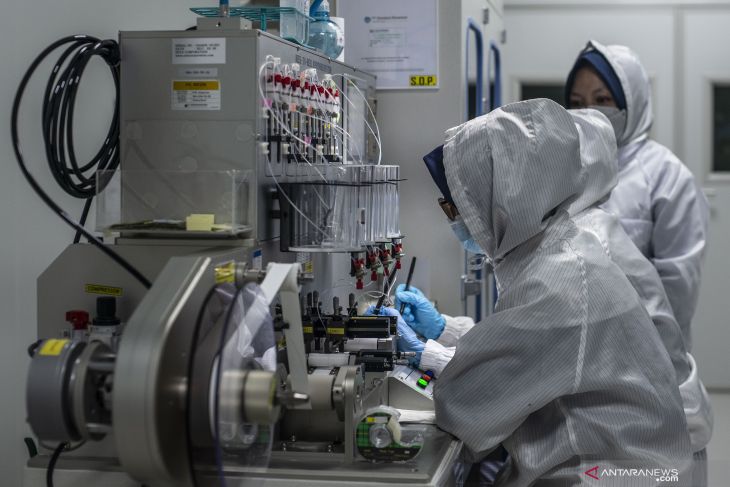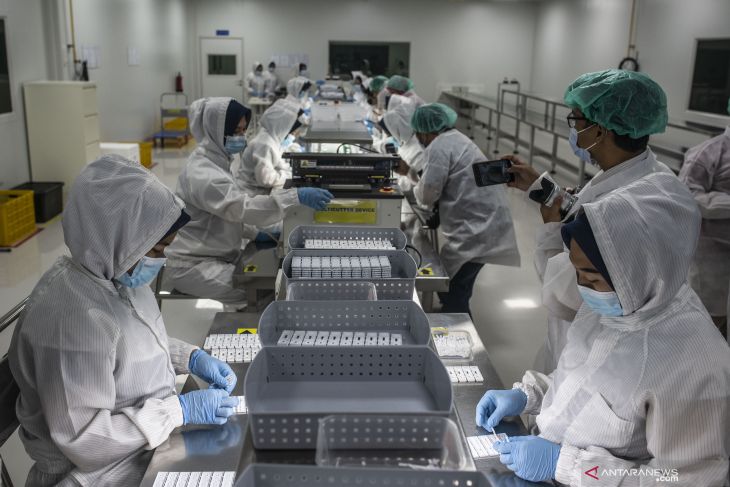another great achievement that wont be mass produced because of Indonesian investor are to scared of all the possibilityITB's Bulletproof Panel Withstands Sniper Shot From 5 Meters
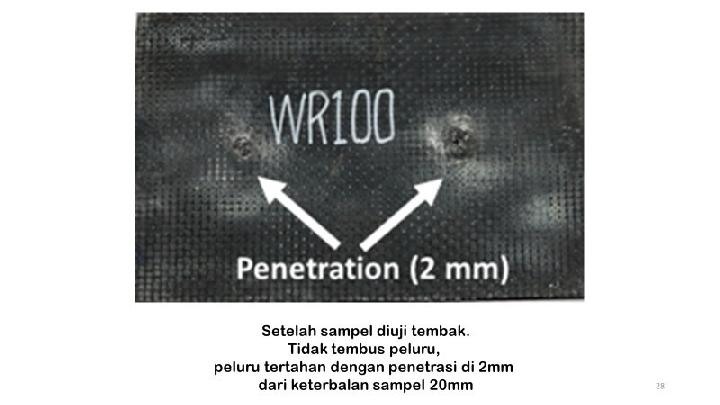
Bulletproof panels made by ITB are made from local materials, namely rubber and hemp fiber. This panel that can replace imported kevlar has been tested by Pindad. (PHOTO/ITB)
The Bandung Institute of Technology (ITB) research team made bulletproof panels using local rubber and hemp fiber. The panel passed a shooting test with a sniper rifle from a distance of five meters.
"The speed of the bullet is up to 856 meters per second and does not penetrate, so we are happy with the result," said Team Leader Mardiyati to Tempo, Wednesday, January 12, 2022.
Apart from Mardiyati, the team also consisted of Ahmad Nuruddin, Arief Hariyanto, Steven, Onny Aulia Rachman, and Muhammad Hisyam Ramadhan, all of whom came from the Materials Polymeter Laboratory. The testing is in collaboration with PT Pindad.
The time of testing is on November 18, 2021, by Pindad staff, with bullets and rifles made by the weapons factory in Bandung. The type of weapon used is the SPR-3 caliber 7.62 millimeters.
During testing, the bullet-proof panel measuring 25.8 x 17 and 2.5 centimeters thick was shot at two points. The ITB research team brought five panel samples. Each panel has a different composition of local materials.
Usually, said Mardiyati, all bulletproof materials use imported materials. For example, Kevlar which uses an epoxy composite, or glass fiber with epoxy.
Starting from the literature study in mid-2020, the ITB team tried to replace it with local materials. The goal is to avoid dependence on foreign countries and comply with domestic component level regulations (TKDN), including for the military.
"Because this is a composite material, we see that natural rubber is very possible to dampen bullets," said Mardiyati. Rubber replaces epoxy, while flax fiber shifts the dominance of glass fiber (fiberglass).
Examples of panels that are made are made from 100 percent hemp fiber. In addition, there is a composition of hemp fiber material of 25, 50, and 75 percent, the rest is mixed with glass fiber.
From the test results, panels made of rubber with 100 percent hemp fiber were proven to fail to block bullets. "The limit is that half of the bullets can enter," said Mardiyati.
The panels with 25, 50, and 75 percent flax fiber successfully resisted bullets. From a panel thickness of 25 millimeters, the bullet only scratches with a depth of 2, 6, and 10 millimeters. "The bullet did not penetrate but stuck in the panel," he said.
The results are also juxtaposed with bulletproof materials which are all imported. Another advantage of the panel that passed the firing test is that it is lighter in weight.
On the 75 percent flax fiber panel, said Mardiyati, it weighs 965 grams. "But if 100 percent glass fiber is almost 1.5 kilograms or 1500 grams," he said.
ITB's Institute for Innovation and Entrepreneurship Development financed the research of this bulletproof panel from natural and local materials with a fund of Rp 150 million.

Other uses, for example, are to protect the underside of helicopters, detention houses, or shelters. However, Mardiyati revealed, recently there was an architect consultant who wanted to discuss the possibility of installing bulletproof panels on the wooden house design.
"It can also be used for vehicles, whether on the door or otherwise, the panels can still be shaped according to the contours because they are flexible and made of natural rubber," added this female doctoral researcher.
The composition of other ingredients is flax fiber 25, 50, or 75 percent, the rest is glass fiber. The advantages of composite materials, he said, "We can adjust to what needs and specifications."
The panel underwent a firing test according to military standards at PT Pindad, Bandung, last November. During the test, the ITB team brought five samples of bulletproof panels, each measuring 25.8 x 17 with a thickness of 2.5 centimeters.
Each panel with a different composition of materials, each shot twice at a different point from a distance of 5 meters. The type of weapon used is the SPR-3 caliber 7.62 millimeters by snipers.
From the test results, the team together with the Institute for Innovation and Entrepreneurship Development, ITB, which financed the research, wanted the panels to be produced. "It can also be made by a local company, we just sell the license," said Mardiyati.
Regarding the price in the market, he hopes to be cheaper than imported products because the main ingredients such as natural rubber and hemp fiber are available in Indonesia.
You are using an out of date browser. It may not display this or other websites correctly.
You should upgrade or use an alternative browser.
You should upgrade or use an alternative browser.
need further testing like, "what happen if got shot from an incendiary rounds?" coz this is rubber we're talking about7.62 mm SPR-3 Bullet only could penetrate 2 mm from 5 m distance? Seems too good to be true. But well, I'm not fully skeptical. This could be installed on helicopter such as those operating in Papua
Investors need to be sure that their investments will be profitable. Unfortunately, if we're talking about defence products in this country, that's still a hard sell - not until our private companies have more 'breathing room' and not just being positioned as supports for SOEs.another great achievement that wont be mass produced because of Indonesian investor are to scared of all the possibility
Var Dracon
Contributor
Interesting... In the acceptance sheet you can read "Low Altitude Deep Penetration (LADP) UAS"IPCD UAV D Fligh Acceptence Test Puslaik Kemhan
It was certified on 21 July 2021
yup, either they just unconfident, scared, or simply just to blind to see / investigate thingsInvestors need to be sure that their investments will be profitable. Unfortunately, if we're talking about defence products in this country, that's still a hard sell - not until our private companies have more 'breathing room' and not just being positioned as supports for SOEs.
Investor - Facility - RnD - Product - User
we already have a pretty good resource in the bold part, but doesn't have a real participant to actually start it or end it
Kerjaan perusahaan swasta kita: nempel sticker

 www.ainonline.com
www.ainonline.com

Optionally-piloted LHD Gains First Order | AIN
Company already has its first order and a pre-series batch of the aircraft is under construction.
Kerjaan perusahaan swasta kita: nempel sticker

Optionally-piloted LHD Gains First Order | AIN
Company already has its first order and a pre-series batch of the aircraft is under construction.www.ainonline.com
Use English lah, no wonder, even SOE doing the same thing
FG to buy aircraft, 2 helicopters, others from Indonesia
The National Agency for Science and Engineering Infrastructure (NASENI) has said it is making plans to procure an aircraft N219, two helicopters and hangar equipment from the PT Dirgantara of Indonesia.
The Executive Vice Chairman/Chief Executive (EVC/CE) of NASENI, Prof. Mohammed Sani Haruna, said the agency has the approval to acquire the know-how from Indonesia on the development of civil and military aircraft.
He spoke on Thursday in Abuja, while receiving the Ambassador of the Republic of Indonesia, Dr Usra Hendra Harahap who led a delegation to the agency on a visit.
Haruna said the federal government’s approval to the agency extends to the development of armoured personnel carriers, other equipment needed by the military and technologies for the production of fertilizers from locally available resources.
He also said the process of acquiring the technology is to first purchase it and then learn how it was assembled and the process of its production.
“It is approved for us to acquire the knowhow from Indonesia on the development of aircraft both civil and military, the armoured personnel carrier and other equipment needed by the military and some technologies in the areas of fertilizer from locally available resources
“The processes of acquiring the technology are for you to acquire it first to learn how to do the assembling and the process, the aircraft will be purchased to enable us to know how to assemble it and in the process, you are learning everything and gradually you will be able to produce different components,” Haruna said.
On his part, Dr Harahap said, “We have the same aim, how to build our countries. Indonesia and Nigeria have a reciprocal transfer of technology, which is why on the aspect of technology we try to share, we need to transfer technology on how to build and maintain aircraft, maintenance and spare parts production.
“The Embassy also received an update of quotation of weapon and vehicles for the Federal Government of Nigeria with the estimated value $57 million.
“The Embassy is also aware that NASENI is intent to procure some product from PT. Dirgantara Indonesia such as Aircraft N219, hangar equipment and two helicopters. In this regard, the embassy is seeking clarification for PT. Dl for the estimated value of the products,” said Harahap.

FG To Buy Aircraft, 2 Helicopters, Others From Indonesia - Daily Trust
The National Agency for Science and Engineering Infrastructure (NASENI) has said it is making plans to procure an aircraft N219, two helicopters and hangardailytrust.com
Radar GCI
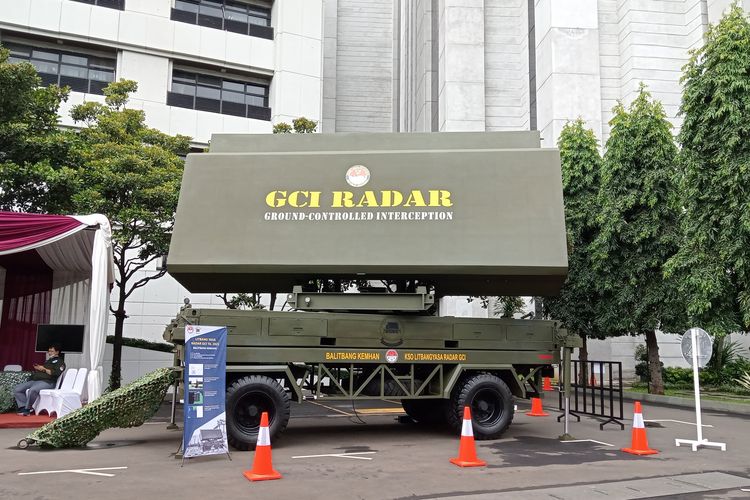
This defense equipment system is part of the production consortium of the Research and Development Agency (Balitbang) of the Ministry of Defense which involves PT Len Industri (Persero), LAPI ITB, Radar Telecommunications Indonesia, and Infoglobal Teknologi Semesta.
This radar is also part of the command, control, communication, computer, intelligence, surveillance, and reconnaissance (C4ISR) program.
This radar is equipped with command and control.
When operating, the GCI radar controller can provide direction and escort to fighter aircraft in conducting intercepts or intercepts.
With these capabilities, the GCI radar has a crucial role in building network centric warfare (NCW), a method of warfare based on real-time communication and data network connectivity from headquarters to combat units and vice versa.

This defense equipment system is part of the production consortium of the Research and Development Agency (Balitbang) of the Ministry of Defense which involves PT Len Industri (Persero), LAPI ITB, Radar Telecommunications Indonesia, and Infoglobal Teknologi Semesta.
This radar is also part of the command, control, communication, computer, intelligence, surveillance, and reconnaissance (C4ISR) program.
This radar is equipped with command and control.
When operating, the GCI radar controller can provide direction and escort to fighter aircraft in conducting intercepts or intercepts.
With these capabilities, the GCI radar has a crucial role in building network centric warfare (NCW), a method of warfare based on real-time communication and data network connectivity from headquarters to combat units and vice versa.

Mengenal Radar GCI, Alutsista Pencegat Pesawat Musuh Buatan Indonesia
Pengontrol radar GCI bekerja atas perintah Panglima Komando Sektor Pertahanan Udara Nasional (Pangkosekhanudnas).nasional.kompas.com
Var Dracon
Contributor
Indonesian Frogs Taxi Drone Will Be Present at Dubai Expo
Frogs Indonesia, a startup engaged in the drone industry, will fly to the Dubai Expo in the United Arab Emirates. Frogs Indonesia was appointed in the delegation chosen by the Ministry of Communication and Information who will introduce domestic technology to the world through the event which will be held from October 1, 2021 to March 31, 2022.
Dubai Expo 2020 took place at Al Wasl Plaza, Dubai, United Arab Emirates. Frogs Indonesia brought its flagship drone products, namely Drone Passanger (Taxi Drone), Sekar Agri (Drone Sprayer), Aksa Mapper (Drone Mapping) and Custom Drone there.
The passenger drone or flying taxi Frogs Indonesia is claimed to be the first to be created and developed in Indonesia, and has been tested to fly. This drone made by a startup from Yogyakarta was also registered as a participant in the Hannover Messe technology exhibition in early 2020.
Taxi Drone was born from the development of the quadcopter drone design. In addition to the control system configuration, its development takes into account aspects such as aerodynamics, structure, and ergonomics. With the engine capacity used, the Frogs taxi drone is designed to carry two passengers with a capacity of 200 kilograms and fly for one hour.
Frogs Indonesia hopes to open the eyes of the world, especially investors, that Indonesia also has the latest technology. "In addition, this event does not only show, but promotes, opens up opportunities for research collaboration and provides comprehensive information that Indonesia has quality products," said Dede Satria Maulana, Chief Business Development Officer of Frogs Indonesia.
With limited time available, Dede added, Frogs Indonesia is trying to prepare all types of drones it has to be brought directly to the Dubai Expo by air. "We hope to make the latest technologies made in Indonesia known in the world and more ogled by investors or developers in the world so that good cooperation can be established in the future."





The company also made agricultural drone, surveillance drone, and cargo drone. Website:
Frogs Indonesia, a startup engaged in the drone industry, will fly to the Dubai Expo in the United Arab Emirates. Frogs Indonesia was appointed in the delegation chosen by the Ministry of Communication and Information who will introduce domestic technology to the world through the event which will be held from October 1, 2021 to March 31, 2022.
Dubai Expo 2020 took place at Al Wasl Plaza, Dubai, United Arab Emirates. Frogs Indonesia brought its flagship drone products, namely Drone Passanger (Taxi Drone), Sekar Agri (Drone Sprayer), Aksa Mapper (Drone Mapping) and Custom Drone there.
The passenger drone or flying taxi Frogs Indonesia is claimed to be the first to be created and developed in Indonesia, and has been tested to fly. This drone made by a startup from Yogyakarta was also registered as a participant in the Hannover Messe technology exhibition in early 2020.
Taxi Drone was born from the development of the quadcopter drone design. In addition to the control system configuration, its development takes into account aspects such as aerodynamics, structure, and ergonomics. With the engine capacity used, the Frogs taxi drone is designed to carry two passengers with a capacity of 200 kilograms and fly for one hour.
Frogs Indonesia hopes to open the eyes of the world, especially investors, that Indonesia also has the latest technology. "In addition, this event does not only show, but promotes, opens up opportunities for research collaboration and provides comprehensive information that Indonesia has quality products," said Dede Satria Maulana, Chief Business Development Officer of Frogs Indonesia.
With limited time available, Dede added, Frogs Indonesia is trying to prepare all types of drones it has to be brought directly to the Dubai Expo by air. "We hope to make the latest technologies made in Indonesia known in the world and more ogled by investors or developers in the world so that good cooperation can be established in the future."





The company also made agricultural drone, surveillance drone, and cargo drone. Website:
Without guard fence those rotor could chop off passenger limb or could act as lawn moweragricultural drone, surveillance drone, and cargo drone. Website:
Indonesian government giving mandate for PT LEN to acquire share of SOE in defense sector through Share transfer
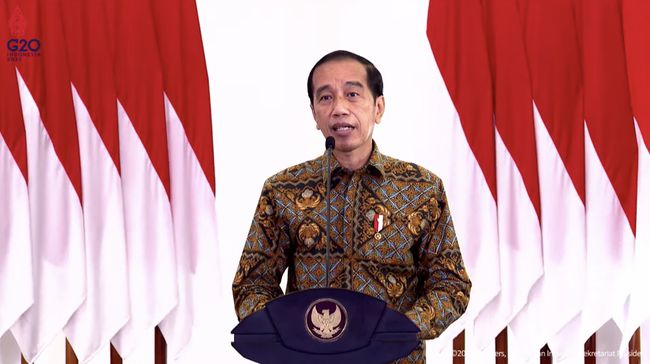
 www.cnbcindonesia.com
www.cnbcindonesia.com

Aturan Terbit! BUMN Len Industri 'Kuasai' PT DI Hingga Pindad
Selangkah lagi, holding BUMN Pertahanan akan terbentuk
Last edited:
So what will change?Indonesian government giving mandate for PT LEN to acquire share of SOE in defense sector through Share transfer

Aturan Terbit! BUMN Len Industri 'Kuasai' PT DI Hingga Pindad
Selangkah lagi, holding BUMN Pertahanan akan terbentukwww.cnbcindonesia.com
Do pindad will be able to produce gun with better quality?
Do PT DI will be able to absorb KFX technology?
Why don't you read the article yourselves? Even from managerial and accounting there is difference, not to mention with how they give annual reportSo what will change?
Do pindad will be able to produce gun with better quality?
Do PT DI will be able to absorb KFX technology?
STTAL Students Create a Solar-Powered Reconnaissance Drone, Can Fly Up to 12 Hours
Students of the naval engineering high school or STTAL Surabaya innovate to make reconnaissance drones that use solar cells or are powered by sunlight. The advantage of using this solar cell, the plane can fly with a duration of almost 12 hours.
The drone, created by three Indonesian Navy soldiers and a three-year diploma student in electronics engineering, STTAL Surabaya, was designed as an enemy reconnaissance aircraft. This aircraft is equipped with cameras and is controlled via a remote controller.
This plane is claimed to be able to fly for 12 hours using sunlight.
Two Median Drones
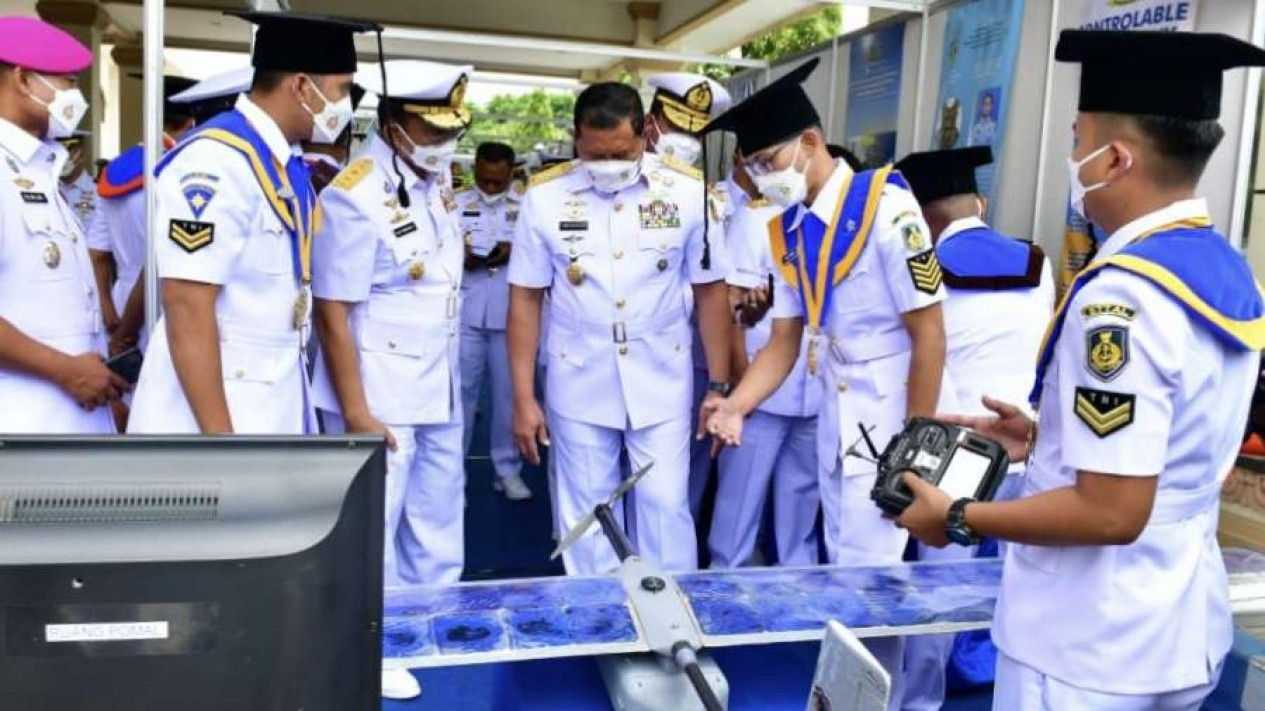
The superior products that amazed the KSAL include two-media drones that can fly in the air and dive in the water, hybrid drones with solar cell energy sources for reconnaissance, riddingbouy with control systems to rescue victims from falling at sea, design and build explosive cones as seabed combat weapons. with a firing device system based on Arduino and LORA micro controllers, as well as a pressure sensor tide gauge with a remote wireless delivery module.
Students of the naval engineering high school or STTAL Surabaya innovate to make reconnaissance drones that use solar cells or are powered by sunlight. The advantage of using this solar cell, the plane can fly with a duration of almost 12 hours.
The drone, created by three Indonesian Navy soldiers and a three-year diploma student in electronics engineering, STTAL Surabaya, was designed as an enemy reconnaissance aircraft. This aircraft is equipped with cameras and is controlled via a remote controller.
This plane is claimed to be able to fly for 12 hours using sunlight.
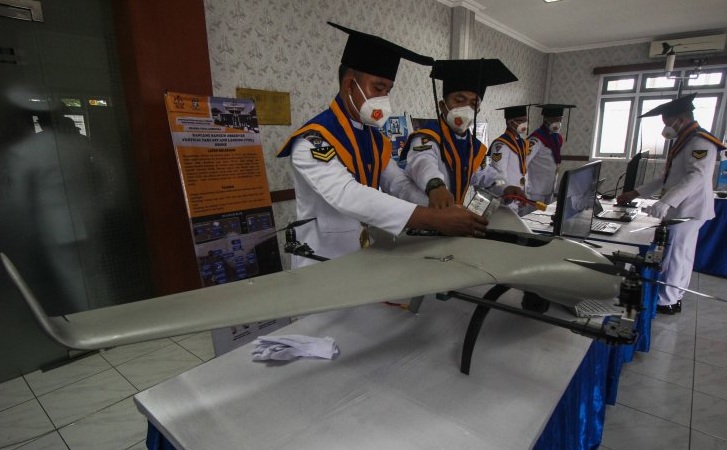
Mahasiswa STTAL Buat Drone Pengintai Bertenaga Surya, Bisa Terbang Hingga 12 Jam : Okezone Edukasi
KSAL Laksamana Yudho Margono meminta inovasi pesawat tak berawak ini dikembangkan lebih lanjut - Kampus - Okezone Edukasiedukasi.okezone.com
Two Median Drones

The superior products that amazed the KSAL include two-media drones that can fly in the air and dive in the water, hybrid drones with solar cell energy sources for reconnaissance, riddingbouy with control systems to rescue victims from falling at sea, design and build explosive cones as seabed combat weapons. with a firing device system based on Arduino and LORA micro controllers, as well as a pressure sensor tide gauge with a remote wireless delivery module.
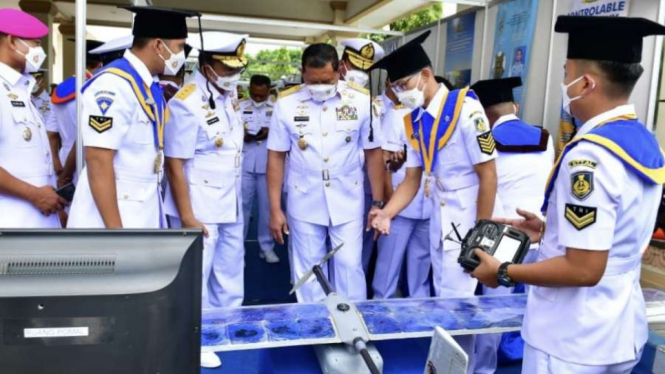
Hadir Wisuda, KSAL Takjub Dengan Drone Dua Media Karya Mahasiswa STTAL
Drone dua media buatan mahasiswa STTAL bisa terbang dan menyelam di airwww.viva.co.id
PLN & PAL Launch Power Plants
Powerful 60 MW

Powerful 60 MW

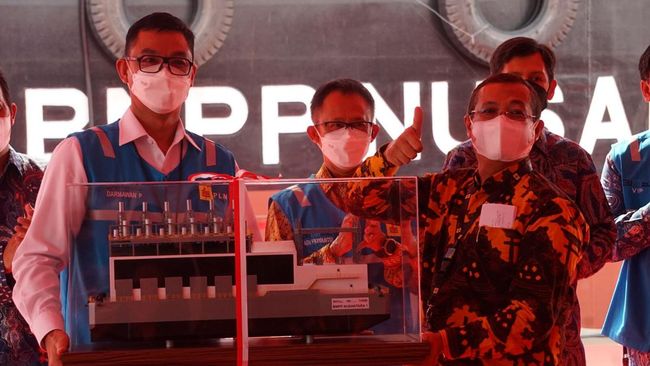
PLN & PAL Luncurkan Pembangkit Listrik Kapal Berdaya 60 MW
Pembangunan pembangkit listrik mobile atau pembangkit listrik yang dipasang pada kapal tongkang dilakukan untuk menyuplai kebutuhan listrik di daerah terpencil.www.cnbcindonesia.com
Prabowo Challenges PTDI to Produce 24 Units of CN235 Aircraft Per Year
Meanwhile, PTDI President Director Gita Amperiawan admitted that he would be targeting a gradual increase in the production capacity of the CN 235 aircraft. "Later on gradually from four, then the second year ten, and the third year is expected to be 24 units," he said.
Seems to me, Prabowo will order some CN 235 for TNI, if not that means asbun AKA NATO (No Action Talk Only)
Meanwhile, PTDI President Director Gita Amperiawan admitted that he would be targeting a gradual increase in the production capacity of the CN 235 aircraft. "Later on gradually from four, then the second year ten, and the third year is expected to be 24 units," he said.

Prabowo Tantang PTDI Produksi 24 Unit Pesawat CN235 Per Tahun
Menteri Pertahanan Prabowo Subianto meminta PT Dirgantara Indonesia (PTDI) menaikkan kapasitas produksi pesawat CN235 dari empat unit menjadi 24 unit per tahun....daerah.sindonews.com
Seems to me, Prabowo will order some CN 235 for TNI, if not that means asbun AKA NATO (No Action Talk Only)
Last edited:


